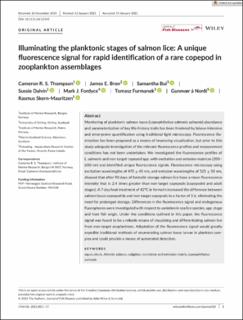| dc.description.abstract | Monitoring of planktonic salmon louse (Lepeophtheirus salmonis salmonis) abundance and parameterization of key life-history traits has been hindered by labour-intensive and error-prone quantification using traditional light microscopy. Fluorescence illumination has been proposed as a means of improving visualization, but prior to this study adequate investigation of the relevant fluorescence profiles and measurement conditions has not been undertaken. We investigated the fluorescence profiles of L. salmonis and non-target copepod spp. with excitation and emission matrices (200–600 nm) and identified unique fluorescence signals. Fluorescence microscopy using excitation wavelengths of 470 ± 40 nm, and emission wavelengths of 525 ± 50 nm, showed that after 90 days of formalin storage salmon lice have a mean fluorescence intensity that is 2.4 times greater than non-target copepods (copepodid and adult stages). A 7-day heat treatment of 42°C in formalin increased the difference between salmon louse copepodids and non-target copepods to a factor of 3.6, eliminating the need for prolonged storage. Differences in the fluorescence signal and endogenous fluorophores were investigated with respect to variation in sea lice species, age, stage and host fish origin. Under the conditions outlined in this paper, the fluorescence signal was found to be a reliable means of visualizing and differentiating salmon lice from non-target zooplankters. Adaptation of the fluorescence signal would greatly expedite traditional methods of enumerating salmon louse larvae in plankton samples and could provide a means of automated detection. | en_US |
